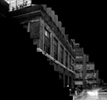Dennis Neuschaefer-Rube
June 12 - July 24, 2010
Opening
Friday, June 11, 7-10pm
       ... ...
In his works Dennis Neuschaefer-Rube investigates different forms of presentation and perception in the media of film and photography. He is particularly interested in the technical possibilities and limitations of these media, which he tries to expand on and rupture.
As is widely known, a film consists of many individual image frames, that are played in fast sequence to generate the illusion of movement and continuity. These individual frames or ‚stills’ Neuschaefer-Rube uses as raw material for his photographic works.
For instance, he puts miniature stills of a Stanley Kubrik film in sequence next and below each other in such a way that a new image is generated. The stills are identifiable as such, but are too small to make out with the naked eye what exactly is represented on them.
Viewed from a distance, the images appear almost entirely abstract. Put in sequence like knitting stiches, the stills form an abstract pattern. They are like ciphers, that represent the film while translating it at the same time. The simultaneity with which each still or scene is present, however, leads to the film’s loss of illusion and legibility.
In ‘Homo Faber’ Dennis Neuschaefer-Rube takes this idea one step further. He also puts stills in sequence, but this time actually in form of a book. The movie ‘Homo Faber’ by Volker Schloendorff, based on the famous story by Max Frisch, finds its way back into the form of a book. The book still contains the story, but now the stills have become cryptic letters – signs without meaning, as the connection has gone missing.
In another series Dennis Neuschaefer-Rube focuses on the time dimension of film. With a large format camera he photographed films in long exposures, leaving the diaphragm open for the entire duration of the film. Due to the longtime exposure, image overlays were generated, that look like clouds of color interspersed with faintly representative scenes. There seems to be alchemy at work here. A process is represented that, while scientifically explainable, remains mysterious.
The fact that one can conceive of film differently in terms of time and space, also becomes apparent in Neuschaefer-Rube’s piece ‘Weekend’. Here, the photographer follows a long-exposure sequence of the film camera as it moves along a street to finally arrive at a scene of an accident. This is a key sequence in Jean-Luc Godard’s famous film. The image of this scene is 15cm high and 10 meters long. The simultaneity of the film sequence questions our perception once again. Are we seeing or reading the image? Obviously, the scene is too long to be grasped at one glance. One has to follow the image, also in terms of space. The illusion of the film sequence is first negated and then re-introduced as a panorama image.
Text: Petra Karadimas |